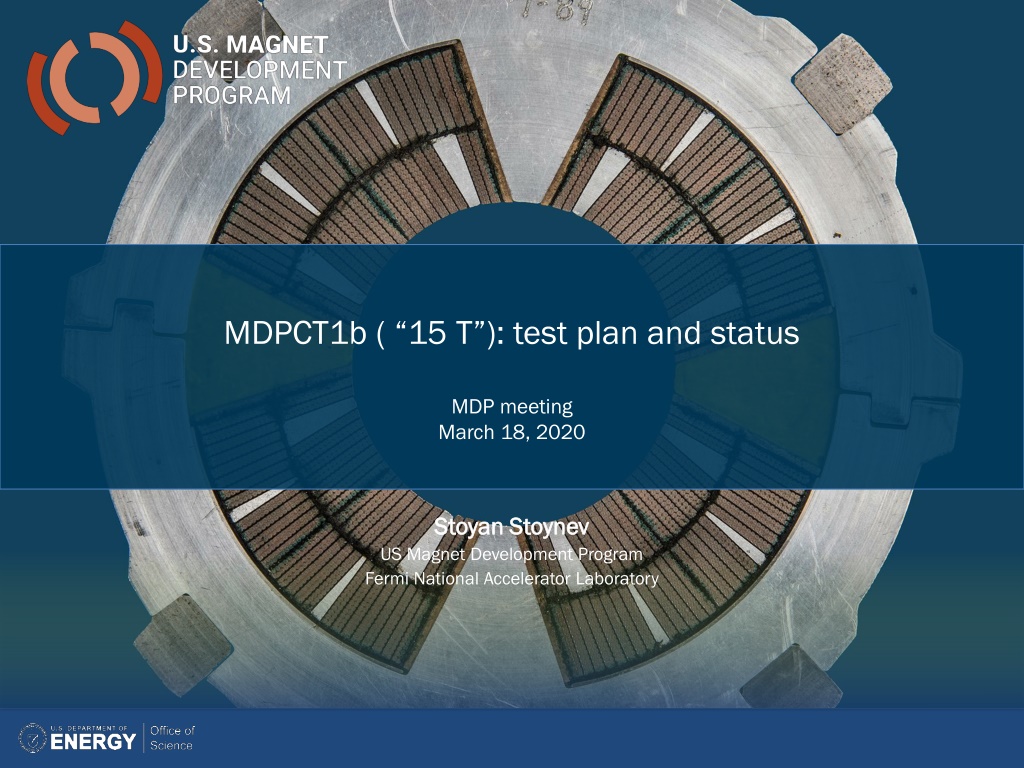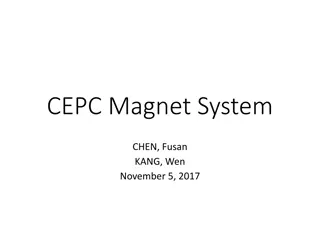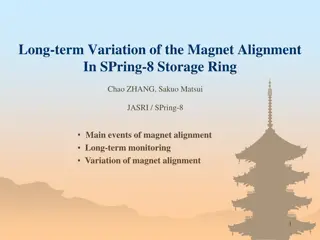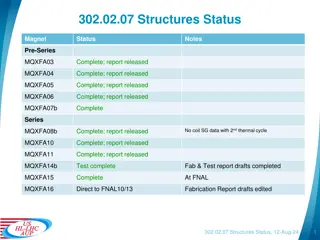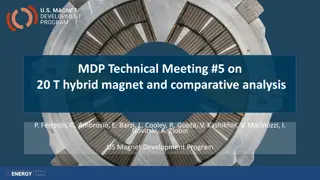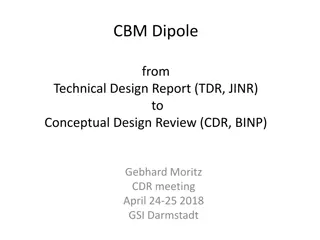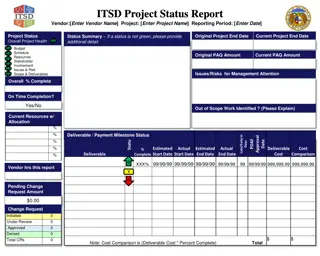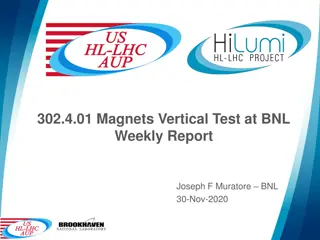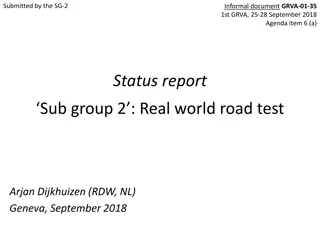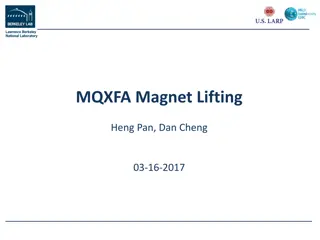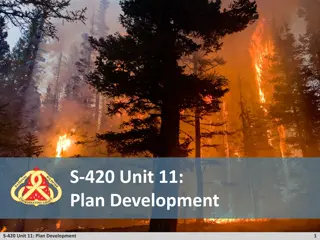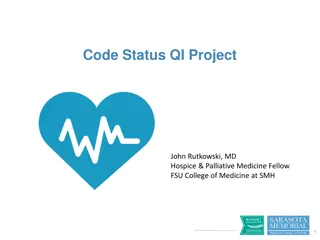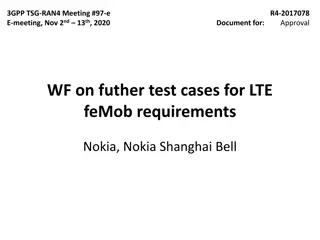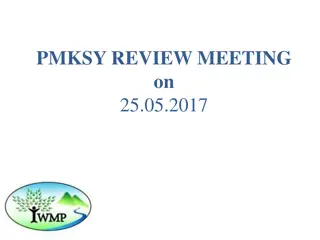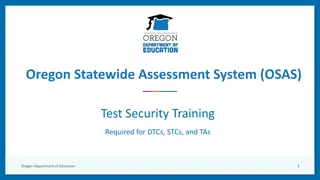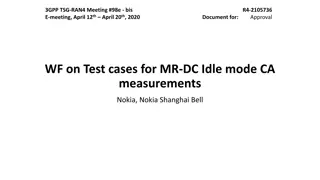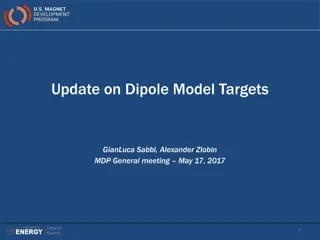Magnet Development Program Test Plan and Status Meeting Overview
The Magnet Development Program Test Plan and Status Meeting held on March 18, 2020, at Fermi National Accelerator Laboratory focused on studying the effects of increased pre-load and altered end-support on magnet performance. The goals included measuring ramp rate, quench current, field quality, and safety operations at high fields. Activities ranged from room temperature preparations to cold measurements after training. The plan outlined specific tests, checks, and measurements to ensure the proper functioning and safety of the magnets throughout various temperature ranges and operational conditions.
Download Presentation

Please find below an Image/Link to download the presentation.
The content on the website is provided AS IS for your information and personal use only. It may not be sold, licensed, or shared on other websites without obtaining consent from the author. Download presentation by click this link. If you encounter any issues during the download, it is possible that the publisher has removed the file from their server.
E N D
Presentation Transcript
MDPCT1b ( 15 T): test plan and status MDP meeting March 18, 2020 Stoyan Stoynev Stoyan Stoynev US Magnet Development Program Fermi National Accelerator Laboratory
Magnet test main goals reminder Study the effect of the increased pre-load and altered end-support on magnet training and training memory Measure ramp rate and temperature dependences of magnet quench current Measure field quality and effects from shims, more detailed studies on decay and snap-back effects Check safety operation at the high field (stress, MIITs) Study protection heater parameters (outer layer and middle layer) 2
Magnet Test Plan Reminder Verify that all configuration files are uploaded to the production area and DAQ computers are rebooted Room Temperature preparation Room Temperature preparation o Electrical checkouts and Hi-pot o Hi-pot schedule: Coil to ground (with heaters grounded or floating) at 1000 V, PH to ground (with coils grounded or floating) at 1000 V. o Check the quench and slow scan data logging o Verify that the VMTF Overview Display is up and running o Initial RRR measurements: check CVT, FVT and Lead signals o Verify that all warm checkouts are completed in the Test Readiness Verification Procedure document (TID-N-769) o Magnetic measurements (z-scan) in VMTF at room temperature Cool down Cool down o Restricted cool down: temperature difference between the magnet top and bottom should not exceed 50 K o Periodically check the SG data logging System checks at 4.5 K with 60 System checks at 4.5 K with 60 m m dump resistor: dump resistor: o Cold Electrical Checkout and Hi-pot, Quench Detection Checkout o Verify that all cold verification steps are completed in the Test Readiness Verification Procedure (TID-N- 769) o Connect the CPS3 power leads and proceed with the AQD/DQD balancing o Ramp to 1000 A, adjust Cu-I AQD balance and perform manual trip o Heater induced quenches at up to 5 kA We are here 3
Magnet Test Plan Reminder (2) At 1.9 K operation with 60 At 1.9 K operation with 60 m Cold measurements after training may have to become part of the second thermal cycle! It depends on test timing and schedule optimization. o The maximum current will be limited to 11 kA o Magnetic measurements at 5.0 kA see the Magnetic measurements plan Z-scan of the main field and field harmonics with both probes Decay and Snap-back measurement with both probes at 760 A during current ramp up o Quench Training at 20/50 A/s to a plateau Plateau is 5 quenches with no improvement above 50 A More than one detraining (above 200 A) quench or multiple detraining quenches at above 50 A will urge a team review meeting Flux-jump measurements Strain gauge and acoustic signal measurement o Ramp rate studies (10/100/200/300/400 A/s) o Magnetic measurements in cycles up to Imax - 500 A see the Magnetic measurements plan Z-scan at different currents (1/5/9 kA) with both probes Decay and Snap-back studies with both probes at currents 300 A and 750 A during current ramp up and down o Temperature dependence studies (2.1/2.7/3.4/4.0/4.5 K) At 4.5 K operation with 60 At 4.5 K operation with 60 m m dump resistor: dump resistor: o Inductance measurements at 50 and 300/200 A/s (and up to 80% of the current reached in training) o Splice resistance measurements m dump resistor: dump resistor: 4
Magnet Test Plan Reminder (3) Warm up to 300 K Warm up to 300 K o Cold RRR Measurements. o Periodically check the SG data logging At 300 K after the test At 300 K after the test o Repeat RRR measurements at room temperature o Magnetic measurements (if needed) Cool down to 1.9 K ( Cool down to 1.9 K (second thermal cycle Cold measurements from the previous thermal cycle after training may have to become part of this one (see above)! Then they will be preformed before the heater tests. o Check training memory o Training to plateau if necessary o Protection heater studies (if safe) minimum power to quench vs current time delay vs current quench distribution and propagation (L2 PH are in between coils) At 4.5 K operation At 4.5 K operation o 2 training quenches at 20/50 A/s second thermal cycle) ) Warm up to 300 K Warm up to 300 K 5
Latest check-out (in-dewar) All VT detection and characterization channels were fine except: Coil 5, VT D3 is N/A not new, known issue, can t be fixed; VT to be skipped as before D7 D2 D1 D4 Layer 4 Layer 4 D3 D5 D6 Coil 4, VT C5 is flaky (sometimes N/A) C3 C7 C4 C6 Layer 3 Layer 3 C5 C1 C2 Coil 4, VS C6_C4 Coil 4, VS C5_C4 [V] [V] From warm RRR data : It suggests the VT insert is touching the next turn. Coil 4, VT C5 is to be skipped in the readout. 6
Latest check-out (in-dewar) (2) Hipot (1000 V) passed, but some readings were higher than usual (still within limits) Coil-to-ground (heaters floating): 6.2 A (non-linear dependence with voltage) Coil-to-ground (heaters grounded): 4.8 A (non-linear dependence with voltage) The coil-to-ground resistance was measured (with ohm-meter) to be below 2 G Heater-to-ground readings were below 0.2 A Earlier hipots on the magnet itself (no top header) showed < 0.2 A currents for all 7
Latest check-out (top header) SG: SG: All Strain gauges are operational. RTD: RTD: One of three temperature sensors on the shell failed won t be repaired (it is at the LE) However, a repaired connection brought the bore temperature sensors back to two QA: QA: Flexible quench antenna (on the bore tube) channels fine. LBNL QA (external) to be deployed later Acoustics: Acoustics: Four acoustic sensors ( old style) operational. (we constantly fail to get comparable results with the new type of acoustic devices; we strongly think sensors should be bolted and not glued to surfaces) Voltage readings (different scales) from acoustic sensors testing magnet hanging over/in the pit RE1 RE2 LE2 LE1 8
Warm RRR data and magnetic measurements All CVT and FVT channels fine, some examples below Current (10 A) Whole/half coil signals Warm magnetic measurements ongoing Warm magnetic measurements ongoing 9
Next steps Restricted T<50 K cool-down over the weekend, possibly starting tomorrow last time it took 76 hours (~ 3 days) Cold check-outs on Monday will likely take two days Training as soon as Wednesday It is reasonable to expect that there will be less people available for support in next weeks and priorities shifted resulting in delays if not suspensions. However: However: We may be allowed to run the test within the minimal Lab operations being prepared We may be allowed to run the test within the minimal Lab operations being prepared (and eventually invoked) (and eventually invoked) 10
Summary Following the developed run plan No signifficant issues encountered, warm steps being finalized Planning for - restricted T cool-down over the weekend (starting tomorrow?), - cold check-outs on Monday and - training later that week We may be allowed to run the test within the minimal Lab operations being prepared We may be allowed to run the test within the minimal Lab operations being prepared (and eventually invoked) (and eventually invoked) 11
Back up 12
